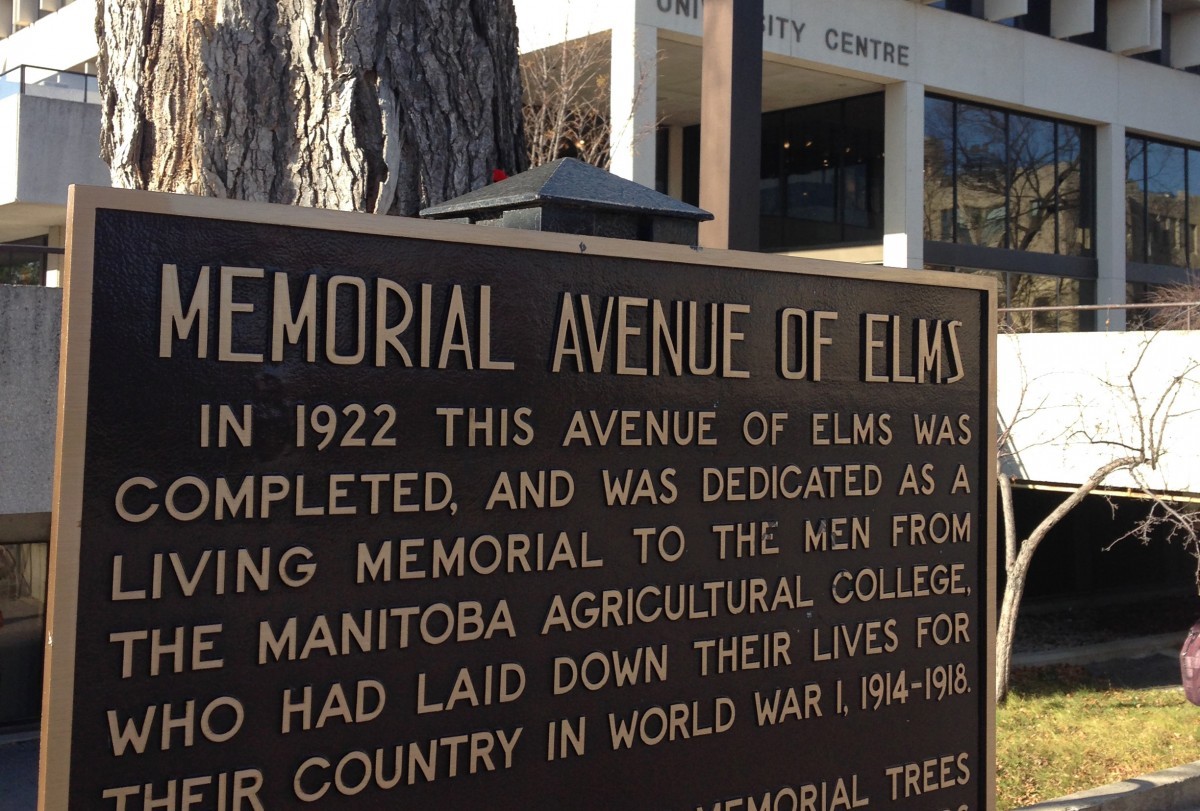
The Avenue of Elms is dedicated to the men from the University of Manitoba who laid down their lives for their country in World War I
Lest we forget
Taken from A Place of Honour a book commemorating Manitoba’s fallen soldiers, the following notes are about some University of Manitoba graduates who gave their lives in the service of our country.
Paymaster Lieutenant Thomas L. Brandson of Winnipeg, was stationed on HMCS Athabaskan. Lieutenant Brandson died on April 29, 1944, at the age of 28 and is commemorated at the Halifax Memorial. The Athabaskan was sunk by a torpedo from a German destroyer while operating in the English Channel. After the first torpedo struck, he was seen safely on deck. However, it was his duty to throw the lead-covered code book overboard and he was down below when the second torpedo struck. Brandson was the son of Dr. Brandur Brandson, a leader in the Icelandic community, professor of surgery at the University of Manitoba and chief of the Winnipeg General Hospital. Brandson choose not to follow in his father’s footsteps; he said he “could not stand to see people suffering.” Instead, he chose training in commerce, and was elected Senior Stick at the University of Manitoba by his peers. Brandson Lake (64 N/13), west of Nueltin Lake was named after him in 1972.
Captain David Stewart Noble of Winnipeg was with the Royal Canadian Army Medical Corps. He died on April 22, 1945, at the age of 27 and is commemorated at the Holten Canadian War Cemetery in Holland. He was the son of David and Dora Noble of Winnipeg. Captain Noble graduated with a degree in Medicine at the University of Manitoba in 1943 and enlisted shortly thereafter. He was killed when the ambulance in which he was riding struck a land mine. Noble Lake (63 O/16), north of Paint Lake was named after him in 1967.
Lieutenant Albert E. Paillé was with the Royal 22nd Regiment. He died on October 21, 1951, at the age of 24 while on night patrol and is commemorated at the United Nations Cemetery in Pusan, South Korea. Albert was born in La Salle, Manitoba, on November 16, 1926. He graduated with a Bachelor of Arts degree from the University of Manitoba on September 22, 1948, having served for four years in the COTC at Currie Barracks in Calgary. He was killed by a mine that blew up while on patrol in No Man’s Land with several of his men who were wounded. The blast was heard by his brother Sergeant John E. Paillé of the PPCLI who had been in Korea since 16 December 1950. Lac Paillé (54 E/12), south of North Norfolk Lake was named after this Korean War casualty in 1989.
While he did not graduate from the University of Manitoba, Flight Lieutenant Peter Murray Anderson of Union Point (J 16379) was with No. 207 Squadron. He died April 11, 1945, at the age of 23 and is commemorated at Brussels Town Cemetery in Belgium. While attending the University of Manitoba in 1941, he joined the RCAF and graduated as a pilot. After his first tour of operations, he received the Distinguished Flying Cross from King George VI at Buckingham Palace. While returning from a bombing mission on his second tour with a badly shot-up plane, his crew bailed out to safety; Murray did not make it out of the plane. Anderson Island (64 J/9) in Tadoule Lake was named after him in 1974. He is also honoured on NTS map 105 H, Yukon.
Reference:
http://www.gov.mb.ca/conservation/lands_branch/geo_names/honour-e/index.html






